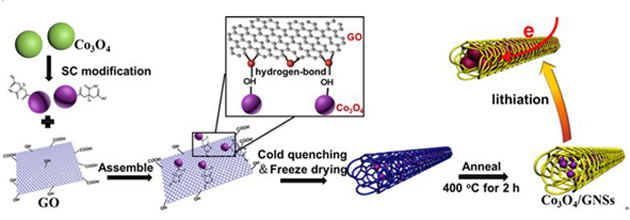Z. G. Zhang, L. Gao, Y. F. Dong, J. P. Zhao*, Z.-S. Wu*
Progress in Natural Science: Materials International, 2018, 28 (2): 212-217.
DOI: 10.1016/j.pnsc.2018.02.005 [PDF]
Invited Research Paper By Guest Editor, Prof. Gaoqing (Max) Lu, of Special Issue on“Nanomaterials for Clean Air, Energy and Water”

Co3O4 is a promising high-performance anode for lithium ion batteries (LIBs), but suffers from unsatisfied cyclability originating from low electrical conductivity and large volume expansion during charge and discharge process. Herein, we successfully constructed the Co3O4 nanoparticles embedded into graphene nanoscrolls (GNSs) as advanced anode for high-performance LIBs with large capacity and exceptional cyclability. The one-dimensional (1D) Co3O4/GNSs were synthesized via liquid nitrogen cold quenching of large-size graphene oxide nanosheets and sodium citrate (SC) modified Co3O4 nanoparticles, followed by freeze drying and annealing at 400 °C for 2 h in nitrogen atmosphere. Benefiting from the interconnected porous network constructed by 1D Co3O4/GNSs for fast electron transfer and rapid ion diffusion, and wrinkled graphene shell for significantly alleviating the huge volume expansion of Co3O4 during lithiation and delithiation, the resultant Co3O4/GNSs exhibited ultrahigh reversible capacity of 1200 mAh g−1 at 0.1 C, outperforming most reported Co3O4 anodes. Moreover, they showed high rate capability of 600 mAh g−1 at 5 C, and outstanding cycling stability with a high capacity retention of 90% after 500 cycles. Therefore, this strategy developed here could be extended as an universal and scalable approach for intergrating various metal oxide materials into GNSs for energy storage and conversion applications. |